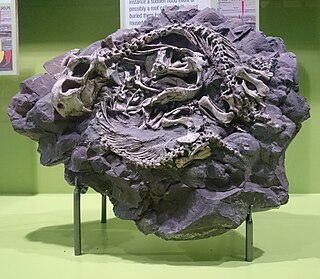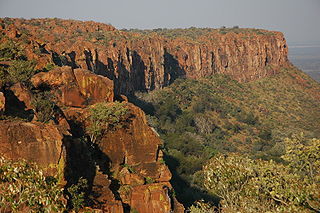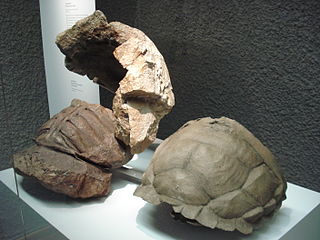
Therapsida is a clade composing of a major group of eupelycosaurian synapsids that includes mammals and their ancestors and close relatives. Many of the traits today seen as unique to mammals had their origin within early therapsids, including limbs that were oriented more underneath the body, resulting in a more "standing" quadripedal posture, as opposed to the lower sprawling posture of many reptiles and amphibians.

Dicynodontia is an extinct clade of anomodonts, an extinct type of non-mammalian therapsid. Dicynodonts were herbivores that typically bore a pair of tusks, hence their name, which means 'two dog tooth'. Members of the group possessed a horny, typically toothless beak, unique amongst all synapsids. Dicynodonts first appeared in Southern Pangaea during the mid-Permian, ca. 270–260 million years ago, and became globally distributed and the dominant herbivorous animals in the Late Permian, ca. 260–252 Mya. They were devastated by the end-Permian Extinction that wiped out most other therapsids ca. 252 Mya. They rebounded during the Triassic but died out towards the end of that period. They were the most successful and diverse of the non-mammalian therapsids, with over 70 genera known, varying from rat-sized burrowers to elephant-sized browsers.

Kannemeyeria is a genus of dicynodont that lived during the Anisian age of Middle Triassic period in what is now Africa and South America. The generic name is given in honor of Daniel Rossouw Kannemeyer, the South African fossil collector who discovered the original specimen. It is one of the first representatives of the family, and hence one of the first large herbivores of the Triassic.

The Cynognathus Assemblage Zone is a tetrapod biozone utilized in the Karoo Basin of South Africa. It is equivalent to the Burgersdorp Formation, the youngest lithostratigraphic formation in the Beaufort Group, which is part of the fossiliferous and geologically important Karoo Supergroup. The Cynognathus Assemblage Zone is the youngest of the eight biozones found in the Beaufort Group, and is considered to be late Early Triassic (Olenekian) to early Middle Triassic (Anisian) in age. The name of the biozone refers to Cynognathus crateronotus, a large and carnivorous cynodont therapsid which occurs throughout the entire biozone.

Stahleckeriidae is a family of dicynodont therapsids whose fossils are known from the Triassic of North America, South America, Asia and Africa.

Ischigualastia is an extinct genus of large dicynodont therapsids that lived during the Late Carnian age and the Early Norian age of the Late Triassic Period. The genus was found in and named after the Ischigualasto Formation of the Ischigualasto-Villa Unión Basin in northwestern Argentina. It has been placed in the family Stahleckeriidae.

Dinodontosaurus is a genus of dicynodont therapsid. It was medium to large dicynodont of the Triassic and had a beak corneum. It lived in the Middle Triassic but disappeared in the Upper Triassic.

Eodicynodon is an extinct genus of dicynodont therapsids, a highly diverse group of herbivorous synapsids that were widespread during the middle-late Permian and early Triassic. As its name suggests, Eodicynodon is the oldest and most primitive dicynodont yet identified, ranging from the middle to late Permian and possessing a mix of ancestral Anomodont/therapsid features and derived dicynodont synapomorphies.

Moghreberia is an extinct genus of dicynodont predicted to have lived only in the mid-Triassic, primarily during the early middle Carnian and found only in the Argana Basin of Morocco. Moghreberia belonged to the Stahleckeriidae family, a group of anomodont therapsids and is most commonly known by its species Moghreberia nmachouensis. Its name is derived from the Arabic phrase al-Maghrib al-Aqsa meaning “the far west”, a term used by Arabic scholars to refer to the approximate region of Morocco, the area in which this animal’s fossil was first discovered. The extinction of many dicynodonts has been attributed to pressures of the Carnian Pluvial Episode, which occurred around 234-232 Ma and generated major ecological and climate changes for years to come.
Sangusaurus is an extinct genus of large dicynodont synapsid with two recognized species: S. edentatus and S. parringtonii. Sangusaurus is named after the Sangu stream in eastern Zambia near to where it was first discovered + ‘saur’ which is the Greek root for lizard. Sangusaurus fossils have been recovered from the upper parts of the Ntawere Formation in Zambia and of the Lifua Member of the Manda Beds in Tanzania. The earliest study considered Sangusaurus a kannemeyeriid dicynodont, but more recent phylogenetic analyses place Sangusaurus within the stahleckeriid clade of Dicynodontia. Until recently, little work had been done to describe Sangusaurus, likely due to the fact that only four incomplete fossil specimens have been discovered.

Tetragonias is an extinct genus of dicynodont from the Anisian Manda Beds of Tanzania. With tetra meaning “four,” and goni meaning “angle,” the name references the square shape of the Tetragonias skull when viewed dorsally. Not to be confused with the plant Tetragonia,Tetragonias were dicynodont anomodonts discovered in the late 1960s by paleontologist A. R. I. Cruickshank in the Manda Formation. Only the type species, T. njalilus, has been recognized.

Kannemeyeriiformes is a group of large-bodied Triassic dicynodonts. As a clade, Kannemeyeriiformes has been defined to include the species Kannemeyeria simocephalus and all dicynodonts more closely related to it than to the species Lystrosaurus murrayi.

Jimusaria is an extinct genus of dicynodont therapsid from the Late Permian (Changhsingian) of China. The type species J. sinkianensis from the Guodikeng Formation in Xinjiang, was originally named as a species of Dicynodon, the first from Asia, but was given its own genus in 1963 before being sunk back into Dicynodon in 1988. The genus was resurrected in 2011 by palaeontologist Christian Kammerer in a taxonomic revision of the genus Dicynodon. Jimusaria was a mid-sized dicynodont, and was similar in appearance to the South African Dicynodon, but differed from it in features such as its narrower snout. A second species, Jimusaria monanensis was described from the Naobaogou Formation of northern China in 2023.

Turfanodon is an extinct genus of dicynodont therapsid from the Late Permian Sunan, Guodikeng, and Naobaogou Formations of China. The holotype of T. bogdaensis was discovered between 1963-1964 and was originally named in 1973 by A. Sun with the type species Turfanodon bogdaensis, Turfanodon was reclassified as a junior synonym of the related Dicynodon in 1988 by G. M. King. T. bogdaensis remained a species of Dicynodon for over two decades before the genus was reinstated in 2011 in a revision of the taxonomy of Dicynodon by palaeontologist Christian Kammerer. A second species from Inner Mongolia, T. jiufengensis, was named in 2021 by palaeontologist Jun Liu from a nearly complete skeleton and other referred bones. Turfanodon was a relatively large dicynodont, and similar in appearance to the related Daptocephalus from South Africa.
Sungeodon is an extinct genus of dicynodont therapsid from the Early Triassic of China. It is known from a single type species, Sungeodon kimkraemerae, which was named in 2014. Sungeodon is the earliest member of a group of dicynodonts called Kannemeyeriiformes, which would radiate later in the Triassic to become the dominant large herbivores of terrestrial ecosystems. Before its discovery no kannemeyeriiform dicynodonts were known from the Early Triassic. The presence of Sungeodon in the earliest Triassic Jiucaiyuan Formation indicates that dicynodonts diversified soon after the Permian-Triassic extinction event, mirroring the explosive radiations of other tetrapod groups such as archosaurs soon after the extinction.

The Omingonde Formation is an Early to Middle Triassic geologic formation, part of the Karoo Supergroup, in the western Otjozondjupa Region and northeastern Erongo Region of north-central Namibia. The formation has a maximum thickness of about 600 metres (2,000 ft) and comprises sandstones, shales, siltstones and conglomerates, was deposited in a fluvial environment, alternating between a meandering and braided river setting.

Etjoia is an extinct genus of traversodontid cynodonts that lived during the Middle Triassic or Late Triassic period in southern Africa. This medium-sized omnivorous cynognathian provides important information on the dental evolution of early diverging gomphodonts and traversodontids.

Proterochersis is an extinct genus of turtle from the Late Triassic period of Europe. It is known from a large number of fossils uncovered in Germany and Poland. The genus was named from fossil remains from Germany in 1913 by Fraas, who recognized two species: P. robusta and P. intermedia. Since then, Szczygielski and Sulej have found that the differences described by Fraas could be the result of intraspecific variation, meaning that P. intermedia are synonymous with P. robusta. They also decided to classify more recent fossil findings from Poland as two new species, P. limendorsa and P. porebensis. A study from 2021 concluded that fossil turtle remains described in 1865 as Chelytherium obscurum are probably synonymous with Proterochersis. Generally, the rules of nomenclature advocate that the oldest taxonomic name should replace more recent ones, but Szczygielski choose to keep the name Proterochersis.

Woznikella is an extinct genus of kannemeyeriiform dicynodont from the Late Triassic of Poland and possibly Germany of Europe. The type and only known species is W. triradiata.






















